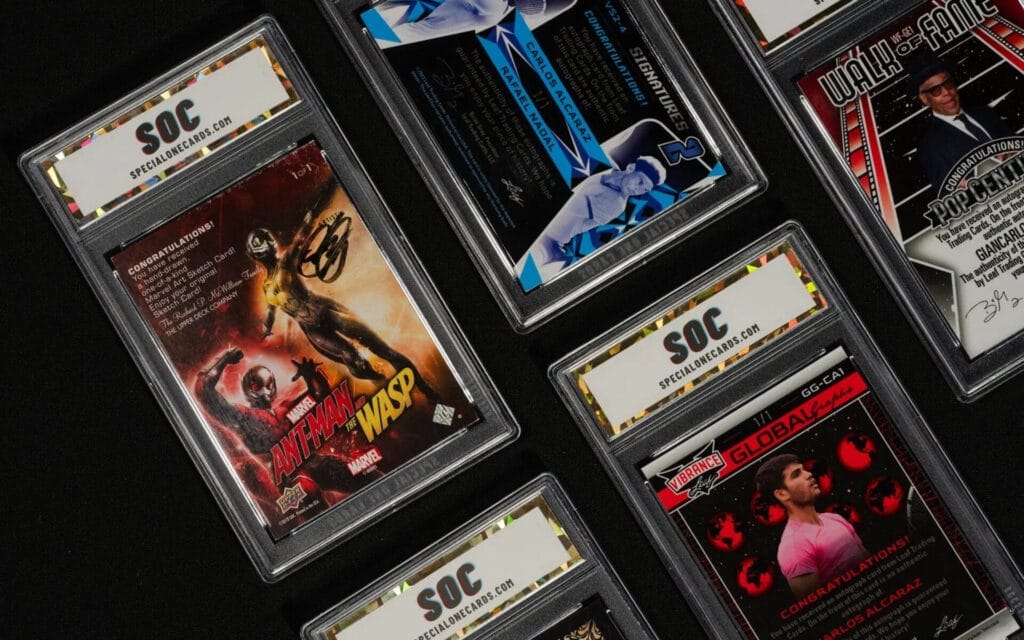The world of trading cards is an exciting, ever-evolving landscape that combines the thrill of collecting with the potential for significant financial return. Whether you’re an enthusiast who’s been collecting for years or a newcomer trying to figure out where to start, you’ve likely encountered some myths along the way. These misconceptions can confuse new collectors and even cause seasoned enthusiasts to make poor decisions.
In this post, we’ll address five common trading card myths that are often perpetuated by hearsay, social media, or misinformation. By separating fact from fiction, you’ll be better equipped to navigate the card collecting world with confidence and success. Let’s dive in!

Trading Card Myth #1: “The Rarity of a Card Guarantees Its Value”
The Reality
It’s a common belief in the trading card community that the rarer the card, the higher its value. While rarity certainly plays a role in determining the value of a trading card, it’s not the sole factor. A card’s rarity only holds weight if there is a demand for it. For example, a card that was printed in limited quantities but wasn’t popular in the first place will have little value despite its rarity.
In contrast, a card that was widely produced but is in high demand due to cultural relevance, popularity, or its connection to a notable player or character can surpass even the rarest cards in terms of value. For example, a common card featuring a popular athlete or a rare holographic version of a trading card from a globally loved franchise like Pokémon may fetch a much higher price than an ultra-rare, obscure card.
Why the Myth Persists
The idea that rarity equals value is rooted in the basic principles of supply and demand. However, in the trading card market, demand is influenced by factors beyond scarcity, such as trends, pop culture relevance, and nostalgia. That’s why some cards from sets that are considered “overprinted” can still carry a hefty price tag while others, despite their rarity, go largely unnoticed.
Trading Card Myth #2: “Grading Doesn’t Matter If the Card Looks Good”

The Reality
Many collectors mistakenly assume that if a card looks pristine to the eye, it must be valuable, especially for highly coveted Special One Cards. However, Special One Cards take card evaluation to a higher level. These unique, authenticated collectibles—often featuring rare designs, player autographs, or limited editions—are thoroughly verified and categorized using the Special One Authentication process. Even the slightest imperfection or exposure to environmental factors like humidity can affect the condition of these cards, impacting their value despite their appearance.
Special One Cards are given a double authentication process to ensure their rarity and condition are accurate, including checks for authenticity, surface quality, and preservation. The SOC label guarantees that these cards are more than just visually appealing; they have undergone a meticulous evaluation that confirms their true worth.
Why the Myth Persists
Collectors may assume that an eye-catching card is automatically valuable, but without verification from a trusted service like SOC, a card’s actual condition and authenticity remain uncertain. Special One Cards stand out not just for their design but because they have passed a rigorous certification process, ensuring their place among the most desirable items for collectors. Proper grading and authentication are critical to preserving their value.
Trading Card Myth #3: “You Need to Spend a Lot of Money to Build a Valuable Collection”
The Reality
While there are certainly high-value cards that cost thousands or even millions of dollars, it’s a misconception that a valuable collection must always come with a hefty price tag. The truth is, building a valuable collection often requires patience, knowledge, and timing rather than just spending large sums of money upfront.
Many collectors start their journey by picking up less expensive cards, often focusing on popular sets, limited-edition releases, or cards that have a strong nostalgic appeal. Over time, these cards may increase in value as demand rises, or as the player’s career progresses or the franchise gains more attention.
You can often find valuable cards in bargain bins or at flea markets if you know what to look for. Some of the best deals come from those who are willing to research the market, attend events, and network with other collectors. Card prices can fluctuate, and opportunities to make profitable purchases are always present for those willing to take the time to learn.
Why the Myth Persists
There’s a prevailing notion that trading card collecting is an expensive hobby—something only reserved for wealthy individuals or investors with deep pockets. This myth is further reinforced by the media, which often covers high-profile sales of expensive cards. However, collectors who take a strategic approach to acquiring cards can build valuable collections without needing to spend a fortune.
Trading Card Myth #4: “Once a Card Is Graded, It Will Always Hold That Grade”
The Reality
One of the biggest myths surrounding trading cards is the assumption that a graded card will always maintain its grade over time. Unfortunately, that’s not the case. While a card’s grade may seem set in stone when it’s first graded, environmental factors and handling can cause the card’s condition to deteriorate, potentially lowering its grade if re-submitted for evaluation.
For example, exposure to sunlight, humidity, or physical damage can degrade the card over time, and what was once a gem mint (grade 10) card could become a near mint (grade 9) or worse if not properly stored and maintained.
Why the Myth Persists
Collectors who haven’t been in the hobby long may believe that a graded card is locked into its condition. However, the market is always shifting, and even the best-preserved cards can suffer from changes in external conditions. This misconception often arises from a lack of understanding of how grading works and the importance of proper card care.
Trading Card Myths #5: “Trading Cards Are Just for Kids”
The Reality
The idea that trading cards are primarily for children has been around for decades. While it’s true that cards were originally marketed to younger audiences, the trading card industry has grown into a multi-billion-dollar market with collectors of all ages. Many of today’s top card collectors are adults who grew up with trading cards and have continued to collect or invest in them as they’ve grown older.
Moreover, the investment potential of trading cards has made them a serious financial asset for many people. Certain cards have appreciated in value, and some even outperform traditional investments. As the market matures, more and more adult collectors are entering the space, not just for nostalgia but for the potential financial rewards as well.
Why the Myth Persists
The idea of trading cards being for children likely stems from the way they were originally marketed and their association with popular children’s games like Pokémon and sports leagues. However, as the market has evolved and the demographic of collectors has expanded, it’s clear that trading cards are no longer limited to children’s entertainment. The value of rare, iconic cards has made them desirable to adults as well.
In conclusion, the world of trading cards is filled with myths and misconceptions, but understanding the reality behind these myths is crucial for anyone looking to collect or invest in cards. By recognizing that rarity doesn’t always equate to value, that grading matters, and that valuable collections can be built on a budget, you’ll be better prepared to navigate the complex card market.
Whether you’re a seasoned collector or a newcomer, keep these truths in mind to make smarter decisions, avoid common pitfalls, and enjoy the thrill of building your collection without falling prey to outdated myths. The trading card world is constantly evolving, and by staying informed, you’ll be able to unlock the full potential of your collection.
This post should provide a comprehensive exploration of some of the most pervasive myths in the trading card community. With a focus on education and myth-busting, it empowers readers to make informed decisions about collecting and investing in cards, all while promoting a greater understanding of the trading card market as a whole.






